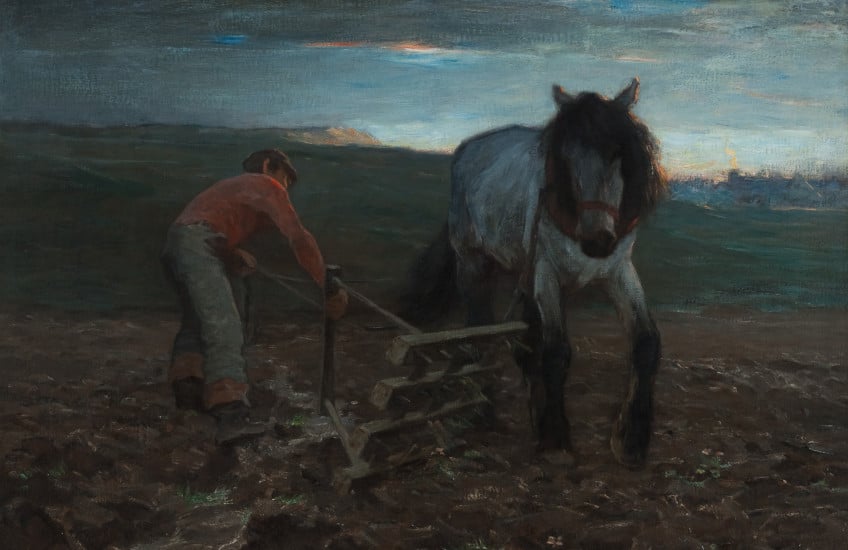
>> How did Turning the Harrow – Early Morning arrive at Agnes and at Queen’s University? This painting has an unusual story in and provenance. Alicia Boutilier, Chief Curator and Curator of Canadian Historical Art at the Agnes Etherington Art Centre discusses the adventurous tale of how the painting was once held at the Metropolitan Museum of Art in New York City and ultimately found its home in the Agnes collection of Canadian Historical Art.
>> Horatio Walker’s Turning the Harrow – Early Morning, has had a winding path of institutional ownership, indicative of changing fashions in art. The Ontario born artist made a very successful living through painting. Horatio Walker was talented, but also trend savvy. When the artist chose rural Quebec as the sustained subject for his art, he was joining a popular movement in American painting. As my curatorial predecessor, Dorothy Farr, has pointed out, it was the Barbizon style that sent Walker to Quebec and not Quebec that inspired a Barbizon style. By the late 1800s, when Walker was painting Turning the Harrow, he divided his time between summers on Île d’Orléans, just east of Quebec City, and winters in New York, where he had an art dealer on Fifth Avenue. He was an elected member of the Society of American Artists, and an associate, later full member of the Royal Canadian Academy of Arts. You could say he held dual artistic citizenship, but his market was really in the U.S. Wealthy Americans who had been collecting European art to represent a cosmopolitan view began to pay serious attention to art produced at home. Significant among those collectors was New York merchant George Arnold Hearn. Hearn was hailed as a contributor to the cause of contemporary American art. And as part of that cause, in the 1910s, he donated two Horatio Walkers, including Turning the Harrow, to the Metropolitan Museum of Art, where he served as a trustee. Turning the Harrow hung for years in the museum. Walker having been fully adopted as an American artist. Then in 1956, the painting was deaccessioned and sold and kind of disappeared from the record. Though the Metropolitan Museum of Art kept its other Walker from Hearn, also of a harrower, American art and Canadian art, for that matter, had moved on to champion other movements by the mid-20th century. Around the same time, the Corcoran Gallery of Art in Washington also deaccessioned their Walker painting, entitled Ave Maria, which is now in the Art Gallery of Hamilton Collection. In 1977, the Agnes Etherington Art Centre mounted a comprehensive exhibition on Walker, with a publication by Dorothy Farr. As part of a professed series of reappraisals of Canadian artists who were important and successful in their own time, but who had fallen out of fashion. There was renewed interest in Walker’s work, as the story of Canadian art was being assembled and historicized in the post-centennial years. At the time of the exhibition, the location of Turning the Harrow was not known. But the ground was set so that when it emerged at auction again in 1994 it was purchased for the collection here. How to look at Horatio Walker today. A privileged artist, claimed, erased, revived, questioned, in two colonial countries, asserting nationhoods. There are so many critical issues raised through such idealization of labour, but I’m still arrested by the painting. It tells me something about enterprises imposed on the world, but also something about colour. The arrest lies not in the high-keyed tones of impressionism or the hot hues of post-impressionism, movements that superseded Walker’s popularity, but in the low light of dawn. The way the horse’s ears and mane are limbed from behind by the same light that catches the farmer’s right shoulder. The silvering of the land before warming up on a chilly morning, Walker really nails it. I retreat temporarily to his use of paint in depicting this scene.